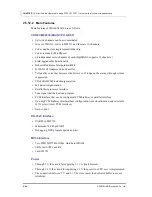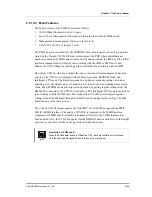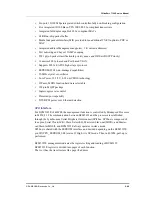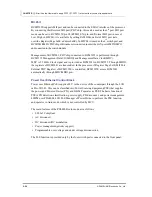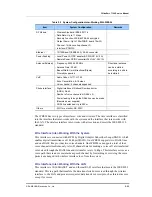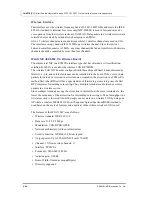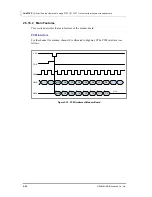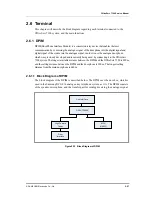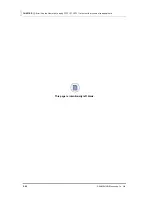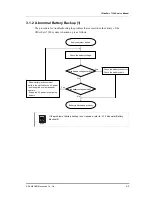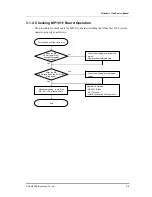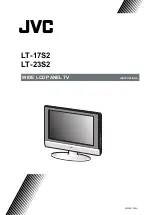
CHAPTER
12
.
Error! Use the Home tab to apply
제목
1,
장
제목
1 to the text that you want to appear here.
2-54
© SAMSUNG Electronics Co., Ltd.
Wireless Interface
This interface uses the wireless frequency band of 2.400~2.4835 GHz and meets the IEEE
802.11b standard. A terminal for voices only(WIP-5000M) is used to forward or receive
voice packets from the wireless section to VoWLAN. Data packets in a wireless section are
forwarded or received by terminals such as laptops and PDAs.
Also, 13 wireless channels are used in Korea while 11 wireless channels are used in USA.
The interfaces occupy bandwidth of 22 MHz per wireless channel. Since the interval
between center frequencies is 5 MHz, any clear channels that do not interfere with wireless
channels should be separated by more than four channels.
WLAN NIC (IEEE802.11b Wireless Board)
The commercial NIC in a PCMCIA interface type that has obtained a wifi certification
certified by WECA is used for the wireless LAN RF WBS24.
The wireless LAN NIC board is configured with three chips of Prism3.0 manufactured by
Intersil Co., Ltd. and external antennas can be installed into the board. If the voice or data
packets forwarded or received in a wireless are occupied in the air section in a CSMA/CA
method first, other BTSs will have opportunities of forwarding or receiving once the first
BTS completes forwarding or receiving. Thus, multiple terminals can forward or receive
packets in a wireless section.
Since multiple terminals occupy the air section in this method, the more terminals are, the
lower the occupancy of the air section for forwarding or receiving is. Thus, throughput in a
wireless section is lowered. About 20 people can use data on a wireless LAN by using one
AP where a wireless IEEE802.11b Direct Sequence Spread Spectrum(DSSS) method is
used based on the users of Internet and e-mails at offices where wireless LAN is used.
The features of the WLAN NIC are as follows:
y
Wireless standard: IEEE 802.11 b
y
Data rate: 11/5.5/2/1 Mbps
y
Modulation: CCK, BPSK, QPSK
y
Network architecture: Ad-hoc, infrastructure
y
Security function: WEB 64/128 bit encrypted
y
Output power: Up to 100 mW(NIC board: 70 mW)
y
Channel: 13(Non-overlap channels: 3)
y
Interface: PCMCIA
y
Frequency: 2400-2483.5 MHz
y
Antenna gain: 2.0 dBi
y
Beam-Width: Omni directional(Dipole)
y
Diversity supported
Summary of Contents for OFFICESERV 7100
Page 1: ...Ed 00 OfficeServ 7100 Service Manual ...
Page 33: ...OfficeServ 7100 Service Manual SAMSUNG Electronics Co Ltd 1 15 ...
Page 189: ...OfficeServ 7100 Service Manual SAMSUNG Electronics Co Ltd 5 3 Soldering Side ...
Page 195: ...OfficeServ 7100 Service Manual SAMSUNG Electronics Co Ltd 5 9 5 7 TEPRI2 Board Part Side ...
Page 197: ...OfficeServ 7100 Service Manual SAMSUNG Electronics Co Ltd 5 11 5 8 8COMBO Part Side ...
Page 199: ...OfficeServ 7100 Service Manual SAMSUNG Electronics Co Ltd 5 13 5 9 16DLI2 Part Side ...
Page 201: ...OfficeServ 7100 Service Manual SAMSUNG Electronics Co Ltd 5 15 5 10 MGI16 MGI32 Part Side ...
Page 203: ...OfficeServ 7100 Service Manual SAMSUNG Electronics Co Ltd 5 17 5 11 16SLI2 16MWSLI Part Side ...
Page 205: ...OfficeServ 7100 Service Manual SAMSUNG Electronics Co Ltd 5 19 5 12 8TRK Board Part Side ...
Page 207: ...OfficeServ 7100 Service Manual SAMSUNG Electronics Co Ltd 5 21 5 13 PLIM Board Part Side ...



